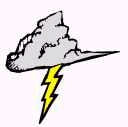Down
| 2. | The falling precipitation and air being dragged down in a thunderstorm form ____. |
| 3. | Some thunderstorms can produce damaging ___, tornados, and flash floods. |
| 4. | The National Weather Service issues a tornado ____ before severe weather develops. |
| 7. | This can be caused by intense rainfall, the failure of a dam, or the thaw of an ice jam. (2 words) |
| 8. | A special type of radar, which has the ability to detect wind speed and direction inside of a thunderstorm. |
| 10. | Strong tornados form in a low cloud that lies just below a thunderstorm, known as a ____ cloud. |
| 11. | A tornado that touches down on water. |
| 15. | For a thunderstorm to develop, plenty of ____ in the lower atmosphere is required. |
| 17. | The sound emitted by rapidly expanding gases that has been heated by lightning. |
| 18. | The National Weather Service issues a tornado ____ if a tornado has touched down, a funnel cloud is present, or if Doppler radar indicates the presence of strong rotation in a thunderstorm updraft. |
| 19. | When upward air cools to its ____ point, condensation begins forming a cloud. |
|
|
Across
| 1. | Thunder travels at the speed of ____. |
| 5. | In 1722, ____ Franklin was the first to demonstrate that a thunderstorm generates electricity. |
| 6. | Thunder and lightning usually start when the formation of a ____ cloud reaches about 25,000 feet. |
| 9. | A region, known as "Tornado ____", with the most tornadoes in the United States extends from the Texas Gulf Coastal Plain northward through eastern South Dakota. |
| 12. | Winds that move vertically upward from the ground. If the winds carry enough moisture, they may condense to form a cumulus cloud. This is one of the first steps towards the formation of a thunderstorm. |
| 13. | Lightning travels at the speed of ____. |
| 14. | One condition for a thunderstorm to develop is a large difference in ____ between the ground and upper troposphere, which creates unstable air. |
| 16. | Thunderstorms need something to give the air an upward shove. This shove can come from heating of air near the ground or by a ____ front, which forces warmer air upward. |
| 20. | A severe thunderstorm that can produce large hail, damaging winds, and violent tornadoes. |
| 21. | A severe thunderstorm requires both a strong updraft as well as a strong ____. |
| 22. | A powerful, funnel-shaped, rotating column of air, which extends from the surface of the earth to a convective cloud. |
|






































































































































































































































































































































































































































































































































































































































































